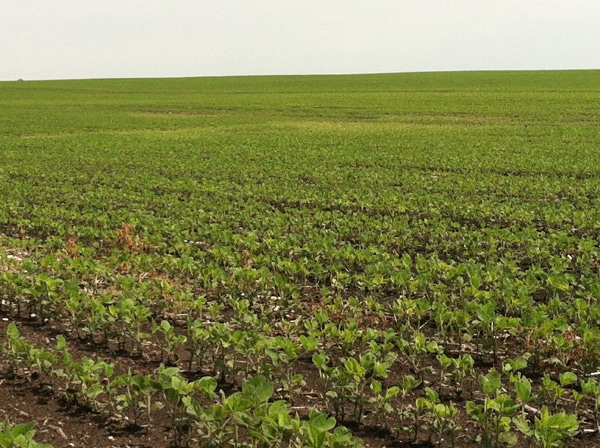June 20, 2012

Potassium (K) deficiency symptoms are developing in corn and soybean crops in many parts of the state, according to University of Illinois Assistant Professor of Crop Sciences Fabian Fernandez. Many farmers are observing this phenomenon for the first time. Conducting nutrient-deficiency diagnostics for crops based solely on visual symptoms is not always easy, but K deficiency symptoms are very distinct for corn and soybeans.
“For both crops, symptoms start to develop in the older leaves with yellowing of the leaf margins,” Fernandez explains. “The yellowing normally starts in the leaf tip and extends to the base of the leaf along the edges of the leaf.”
In more severe cases the leaf edges look dead (brown) while the new leaves remain green because the K in the older tissues is remobilized to supply K to the newer tissues.
“Sometimes people confuse K deficiency symptoms in corn with nitrogen (N) deficiency,” Fernandez says. “While N deficiency also occurs in the older leaves starting at the tip of the leaf, yellowing develops along the midrib toward the leaf base forming a ‘V’ shape.”
What is causing the deficiency?
The symptoms that are showing up in so many fields reflect either 1) insufficient supply due to low soil-test K levels or 2) reduced potassium availability due to less-than-ideal soil conditions and slow root activity.
A survey conducted in 2007-2008 found that K levels in approximately 45% of nearly 550 randomly selected Illinois fields were below the critical level needed to maximize yield. “When soils are below the critical level there is a strong probability of yield reduction even if the crop does not develop deficiency symptoms in the leaves,” says Fernandez.
He says that this year, the appearance of deficiency symptoms is a signal that K should be applied this fall. “The crops in most of these fields will likely not recover even after growing-season conditions improve,” he cautions.
Some fields are showing K deficiency despite having adequate soil-test K levels. This problem is due to the dry soil. Potassium ions need water to diffuse in the soil solution from areas of high concentrations near the soil particles to areas of low concentrations near the crop roots. When soil pores have more air than water, the K ions cannot reach the root because they cannot diffuse through air.
“Under droughty conditions, as far as the crop is concerned, it is as if the ions were not present,” Fernandez explains. “The problem should disappear soon after growing-season conditions improve.”
Dry conditions also limit root growth and activity, further reducing the crop’s capacity to take up potassium. Other factors that could limit root growth include: soils that are too loose or compacted, root damage by disease or insect pruning, shallow seed-planting depth and seed-furrow sidewall compaction that occurs when planting in wet soils
What can be done?
The best way to supply K is to apply it in the soil before planting. Similarly, the management practices to prevent soil conditions that intensify the negative effect of dry weather on K availability are also done before planting. Thus, there is very little that can be done to correct the problem for this year’s crops.
If factors other than low soil-test K are causing the deficiency, applying K fertilizer to the soil is not likely to be profitable for the current crop. Even in low-K soils a liquid or dry application between crop rows will not be effective unless there is enough rain to move potassium into the root zone.
However, even if there is not sufficient rain to move the K, Fernandez points out that the application can begin to correct soil K levels for the next crop. An advantage of soil applications is that higher rates can be applied relative to foliar applications.
Research in the Midwest has shown that foliar potassium applications have limited and inconsistent results and are usually not profitable. “To my knowledge, none of the trials showing response to foliar applications occurred under droughty conditions,” says Fernandez. “If a foliar potassium application is deemed necessary, I recommend using fluid products that do not contain potassium chloride, potassium sulfate or other products with a high salt index so higher potassium rates can be applied without danger of canopy injury.”
Fernandez suggests looking for clues that may be useful when developing strategies to address the problem. “Take note of the general condition of the roots and the physical condition of the soil, and collect soil samples for potassium analysis from adjacent areas with seemingly normal growth and potassium-deficient symptoms,” he advises.
In most fields, some areas are more severely affected than others. “It would be advisable to mark those areas with a hand-held global positioning system and go back after harvest to take samples and possibly target the area with variable rate applications,” he says.
You May Also Like




